
Rejecting candidates in a thoughtful manner is not just a decent thing to do - it can also boost your employer brand. You turn down 99% of your candidates. Don’t miss the opportunity to turn them into eager employer brand ambassadors!
Rejecting candidates in a thoughtful manner is not just a decent thing to do - it can also boost your employer brand. You turn down 99% of your candidates. Don’t miss the opportunity to turn them into eager employer brand ambassadors!
How many applicants did you get for your last opening? And how many of them did you reject? 🤔
Exactly.
All of them were attracted to your employer's brand and eager to work for your company. And now, when they got rejected, they are, at best, slightly disappointed and neutral about your employer brand. 😐
But what if I told there is a way to turn your rejected, unhappy candidates into your biggest fans?
Those who will leave positive reviews on your company’s Glassdoor profile, tell all their friends about the best job interview they ever had, and even Tweet about it?
Yep, it’s possible. 🙂 And it’s well worth the effort.
Let’s look at the stats and figures. 👀 📊
Here is what you can expect:
1. You’ll lose them (to your competitors) forever!
2. They'll tell everyone about it.
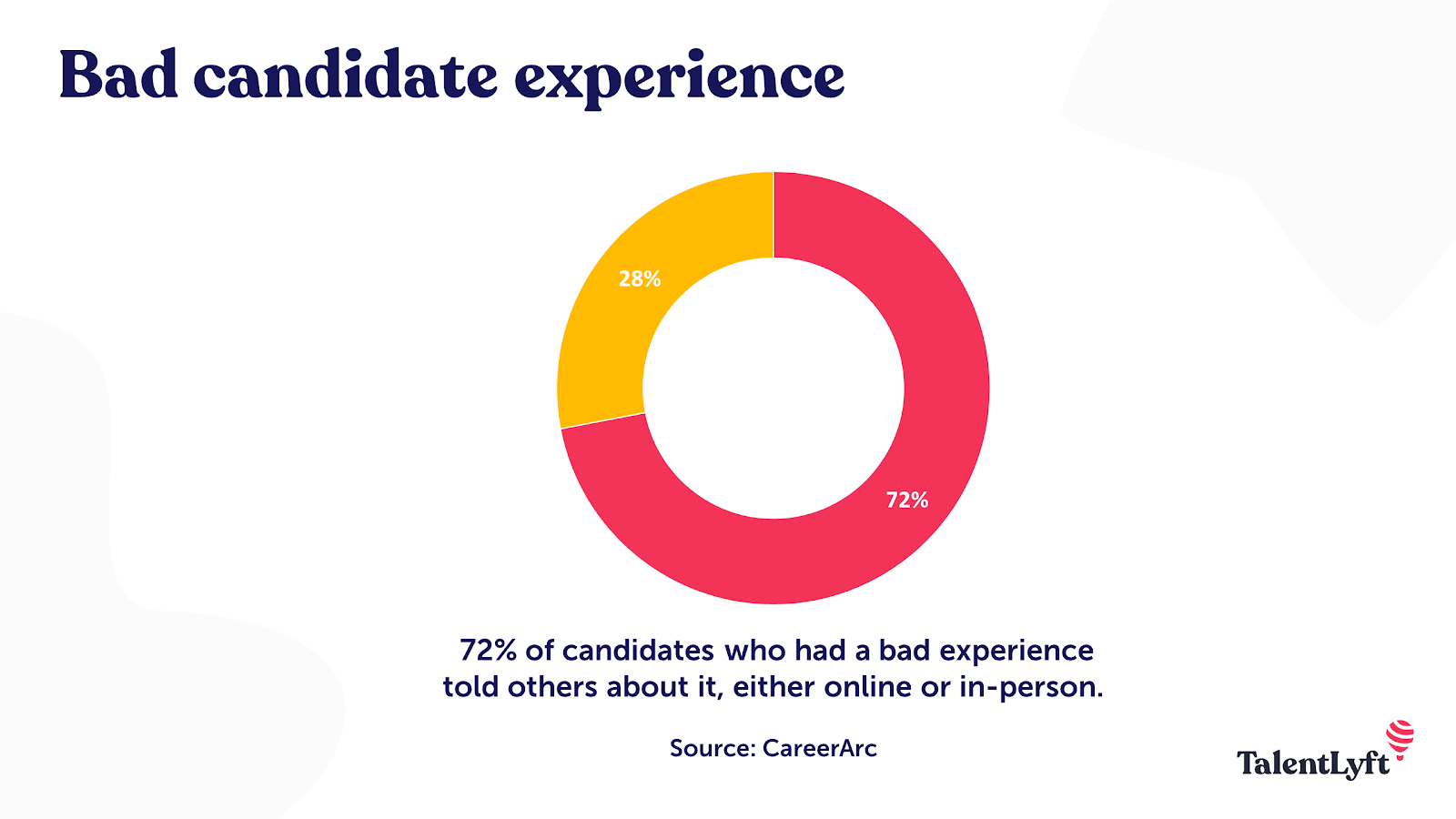
3. You’ll lose money.
⚠️ For example, Virgin has calculated the value of their bad candidate experience and was shocked to find that rejected candidates cost Virgin Media $5M annually!
Well, then you’ll reap amazing benefits:
1. They’ll reapply!
2. They’ll refer great candidates.

3. They’ll boost your employer brand - for free!
4. You’ll make money.
Enough said.
Now, let’s see how to turn your rejected candidates into eager employer brand ambassadors! 💪
Once rejected, candidates will feel slightly disappointed. However, their candidate's journey doesn’t have to end with a bitter taste. Actually, it doesn’t have to end at all!
Do your best to stay connected with your rejected candidates. Who knows, maybe they’ll be a perfect fit for one of your future job openings!
So without further ado, here is how to build a continuous relationship with your rejected candidates and turn them into avid employer brand ambassadors in just 6 simple steps:
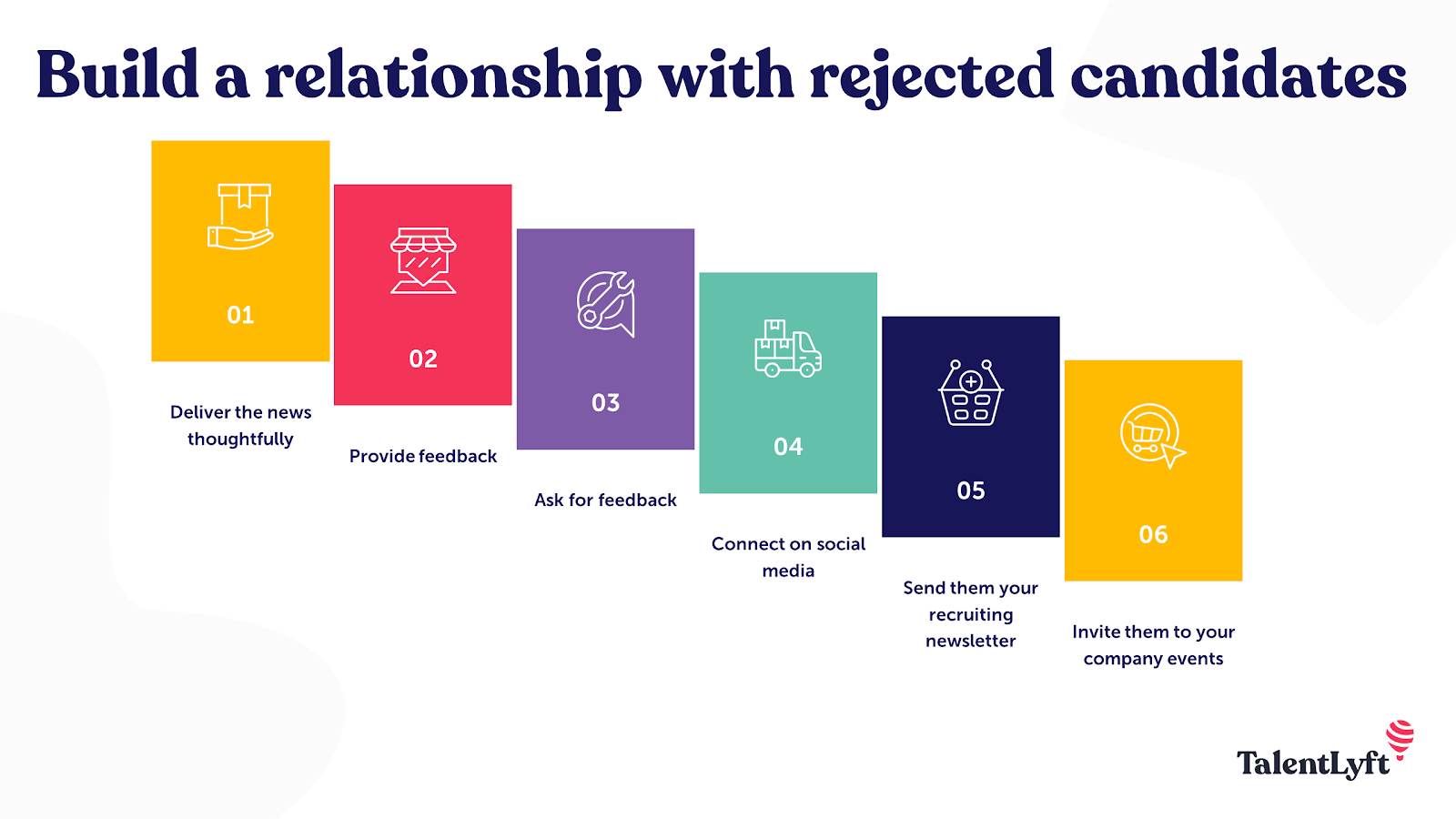
Rejecting candidates is never easy, but it can still be done thoughtfully and respectfully.
First of all, make sure you deliver the news in a timely manner. Contact candidates who didn’t make it into the next round of your hiring process ASAP. The best practice is to contact candidates within 48 hours after the interview.
If it is possible, deliver the news over the phone. Talent Board’s latest Candidate Experience (CandE) Benchmark Research Report has found that the candidate experience improves by 29% if you reject candidates over the phone as opposed to email or text message.
If you have a lot of candidates so it is impossible for you to call all of them, make sure to send them a personalized and carefully crafted candidate rejection email template.
💡 PRO TIP: A great way to differentiate your employer brand is to send candidates an email containing personalized video messages. Here is an example of a great candidate rejection video:
*This video was created with the video email software Covideo.
Most candidates will truly appreciate receiving your feedback. According to LinkedIn’s research, 94% of candidates want to hear feedback after an interview.
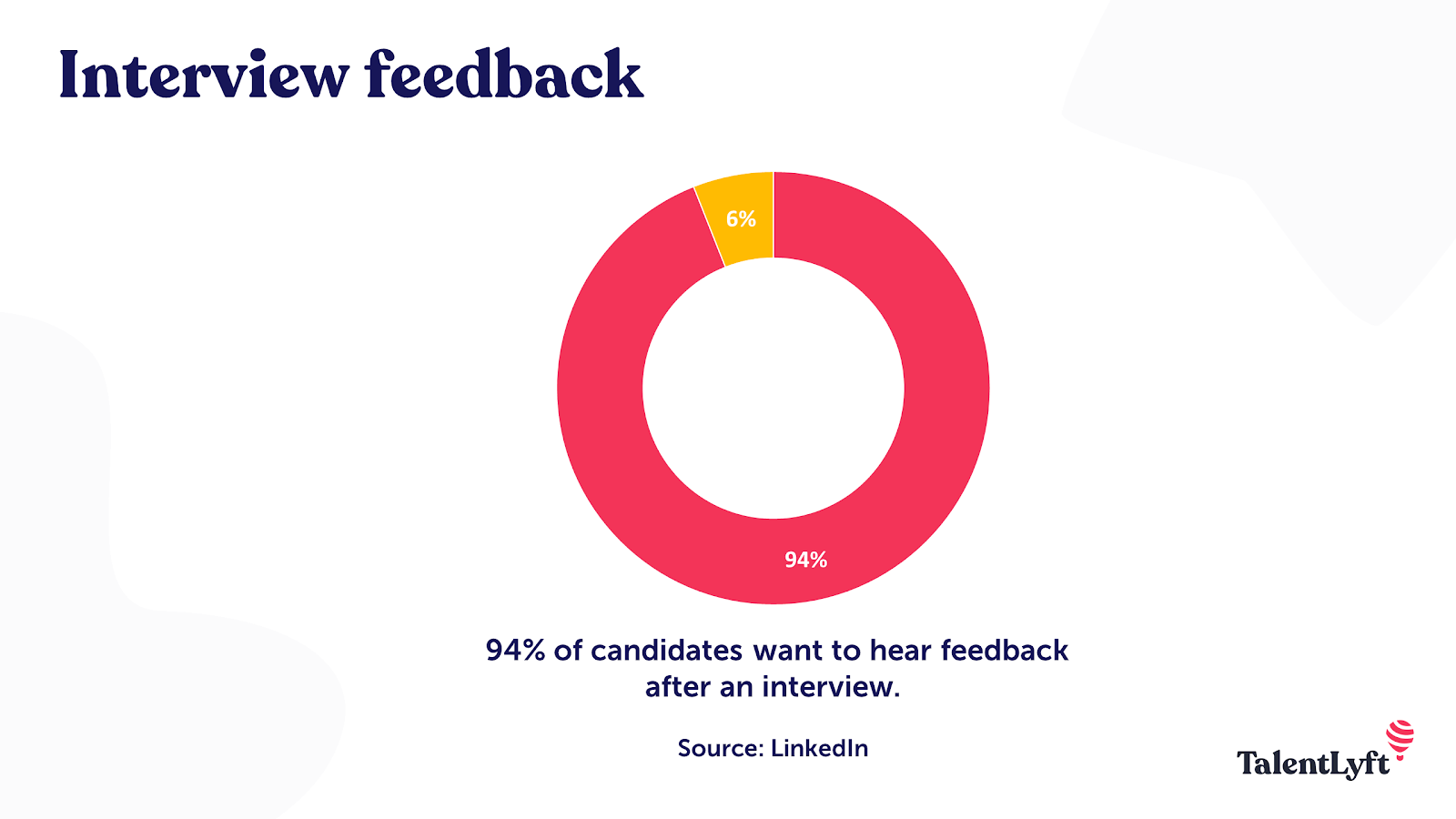
Furthermore, rejected candidates are 4x more likely to consider your company for a future opportunity when you offer them constructive feedback.
However, you can never be too careful or polite, so make sure to ask your rejected candidates if they want to hear your feedback before you deliver it. Nine times out of ten they will, but if they don’t, don’t force it on them.
First of all, make sure your feedback is honest. Don’t try to sugarcoat it because you will come out as dishonest. Try to keep the balance by offering a mixture of praise and criticism, as too much criticism creates defensiveness and too much praise sounds insincere.
Be direct. Don’t beat around the bush with generic feedback lines such as “The other candidate was more experienced”. Tell them exactly in which areas the winning candidate was more experienced and knowledgeable.
💡 PRO TIP: Make sure to give your rejected candidates actionable advice that can help them in their future job applications. If it’s appropriate, you can even suggest certifications or courses they might consider undertaking to further advance their knowledge and expertise.
Besides offering your feedback to rejected candidates, you should also ask them for feedback on your hiring process. This will send the message that you really care about their opinion and are trying to make an effort to provide an excellent candidate experience.
Unfortunately, most employers don't ask candidates to provide feedback on their candidate experience. 75% of candidates say they were never or rarely asked for feedback, according to recent Talentegy’s Candidate Experience Report.
Among those companies that ask for feedback, most make the mistake of asking candidates to rate their overall candidate experience on a quantitative scale. Alternatively, they use a candidate experience net promoter score asking candidates one of these questions:
“How likely are you to apply again for a job at [Company Name]?”
“How likely are you to refer others to apply for a job at [Company Name]?”
While these questions might be indicative of the state of your candidate's experience, unfortunately, they won’t provide any specific insights into what exactly needs to be improved or what works best. By asking these questions, you’ll find out only if you’re doing something right or not, but you won’t be able to get any actionable pointers.
This is why I recommend creating a more sophisticated candidate experience survey. It doesn’t have to be too comprehensive though. You can simply add one additional open question asking candidates to suggest specific areas you can improve.
💡 PRO TIP: Besides inviting candidates to complete your candidate experience survey, you can also ask them to leave a review on Glassdoor or share their opinion over the phone. These are all great ways to find out exactly what you need to improve.
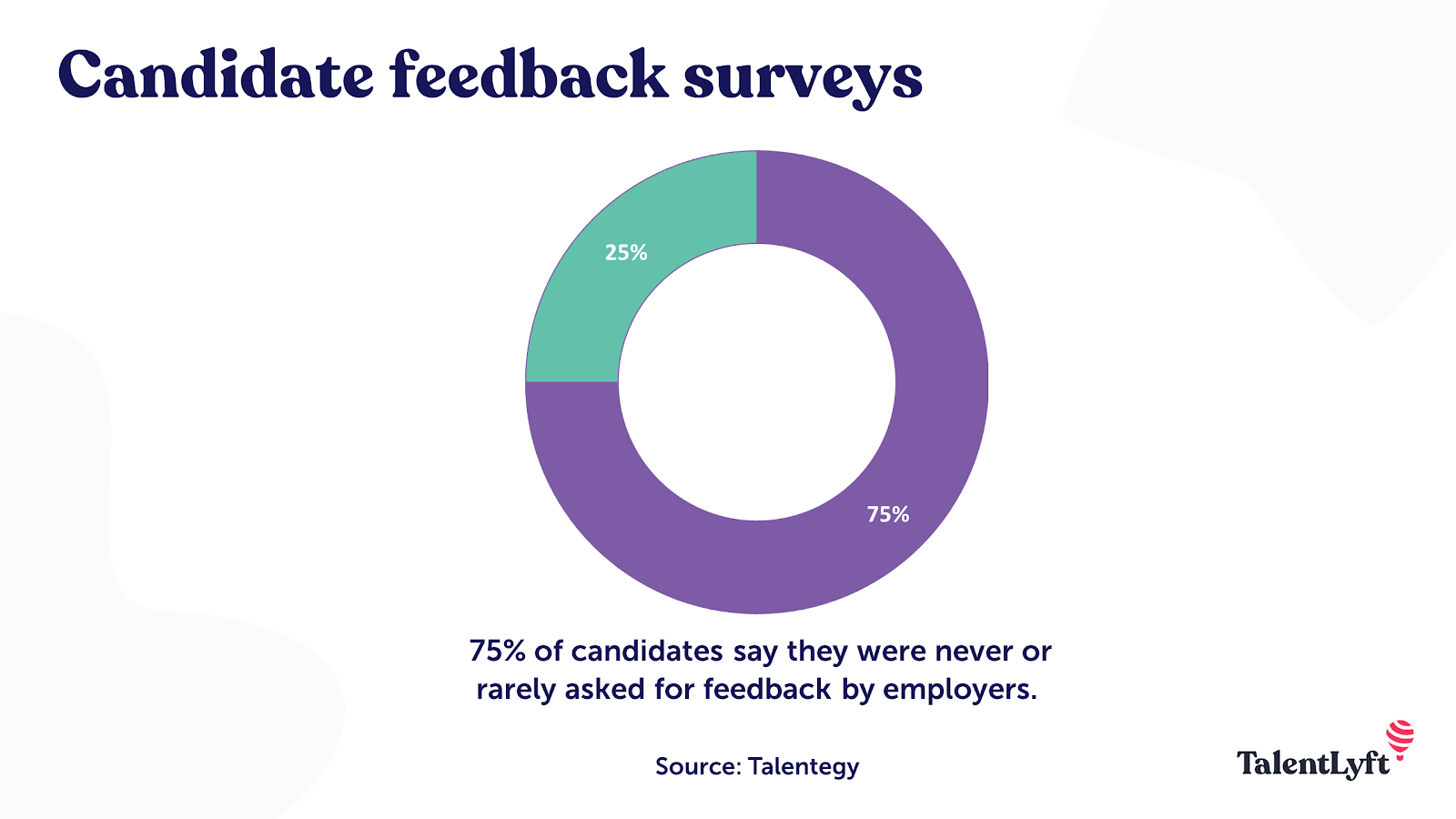
Make sure to connect with your rejected candidate on social media. This is a simple way to leave a positive impression and show you care about keeping in touch with your candidates, even if you didn’t end up hiring them.
Although many companies invite candidates to follow them on social media, in my opinion, this may not be the best approach in the context of the candidate rejection process, as it may seem impersonal and mechanical.
Besides, rejected candidates probably won't be thrilled to follow your company on social media after they got rejected by you, since it means that your company’s postings will follow them around and keep reminding them of being rejected.
Instead, you should connect with your rejected candidate in a personalized way.
💡 PRO TIP: Your recruiters, hiring managers or any other people who actually meet your rejected candidates should extend them with an invitation to connect on social media, preferably on LinkedIn.
Hopefully, you already have a recruiting newsletter you regularly send to your talent pool. If you do, make sure to add all of your rejected candidates on your mailing list.
This is a simple, quick, and practically effortless way to stay connected with your rejected candidates. After all, they might be a perfect fit for one of your future job openings. Or know someone who is. 😉
If you don’t have time or resources to create and send regular recruiting newsletters to your talent pool, you should at least send them an occasional email campaign. Even if you can send just one email per quarter, this can still be very beneficial.
By keeping in touch with your rejected candidates via email campaigns, you can stay on top of their minds, keep them engaged and notify them when you have new job openings they are qualified for.
Just make sure not to bombard your candidates only with your new job openings. Instead, offer diversified, interesting, and useful content. For example, let them know about your company’s recently won awards and new, exciting projects your employees are working on.
Make sure to also showcase your company culture by featuring employees’ testimonials and reports from your company’s annual team building. Use real-life photos and videos of your employees and events.
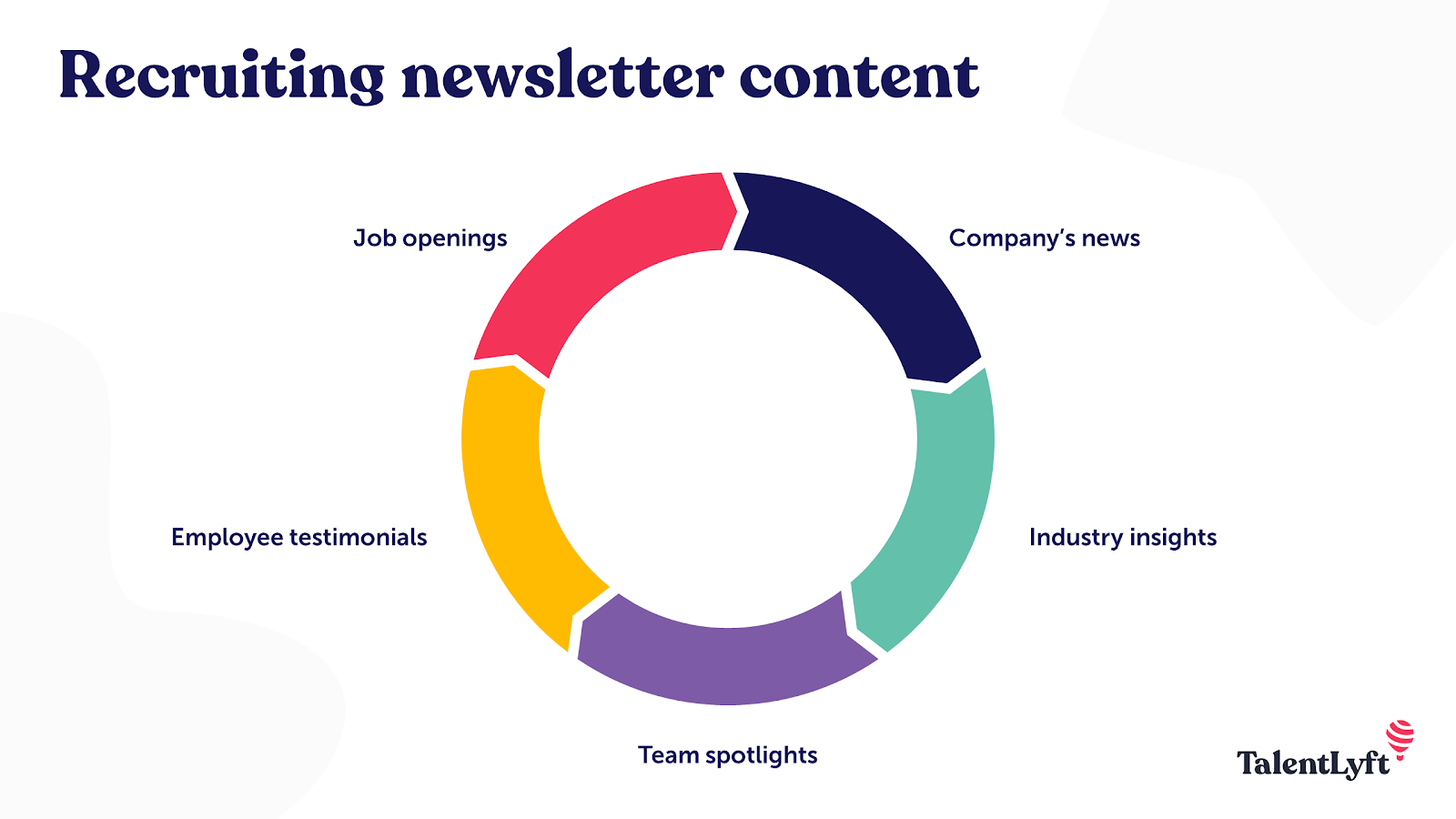
💡 PRO TIP: For even better results, you should segment your talent pool and send your rejected candidates personalized highly targeted email campaigns.
Another great way to keep in touch with your rejected candidates is to invite them to your company events. And I don’t mean just strictly recruiting events such as Career Days or Job Fairs.
Does your company organize internal educational events such as meetups, workshops, or hackathons? Consider inviting a few silver medalists to attend them. It won’t cost you much, just a few additional chairs and pizzas, but it can do a wonder for your employer brand.
With a little bit of effort, you can position your company’s events as a go-to educational and networking place for top talent. Instead of going out there and searching for the best candidates, you can make them come to you.
A great way to start building a talent community is by inviting your silver candidates to attend your events.
💡 PRO TIP: If you can’t afford the time or space to accommodate all of your silver medalists, consider organizing online events, such as webinars, which can be way more affordable and inclusive.
If you really want to differentiate your employer brand, stand out from our competitors and absolutely delight your rejected candidates, you’ll need to go the extra mile.
However, this doesn’t have to be an expensive or time-consuming endeavor! Even a small gesture can mean a lot if it is delivered thoughtfully

For example, you can give your candidates a small gift, such as a lunch or coffee gift card. That way, they can grab a coffee and/or lunch in the nearby restaurant after their interview at your office.
Another great idea is to deliver a bag of coffee or sweets to your candidate's home address. For a special, personalized touch, include a handwritten note thanking them for their time and stating you’re happy to have had a chance to meet them.
If this seems like too much of an effort, you can always give your candidates a discount or a coupon for your products or services.
Another great idea is to give your candidates the company’s swag products you already have lying around, such as branded T-shirts or a hoodie, notebooks, water bottles, totes, etc.
💡 PRO TIP: Of course, depending on your budget, this could be something you'll need to reserve for those candidates who are most important to you, such as silver medalists, executive candidates, and qualified candidates for your hard-to-fill roles.
The sole act of rejecting a candidate, no matter how thoughtful, can’t redeem a bad candidate experience in the earlier phase of your recruitment process.
Make sure to provide an excellent candidate experience on each step of your candidates’ journey:
➡️ Learn how to Improve Candidate Experience in 10 Simple Steps!
To summarize, here are the top 4 tips for turning rejected candidates into avid employer brand ambassadors:

Communicate that they didn’t get the job ASAP. Pick up the phone. Personalize. Be honest.
Give and ask for feedback. Tell candidates how they can improve. Ask how you can improve your hiring process, too.
Connect with your rejected candidates on social media. Invite them to your recruiting events. Send them personalized email campaigns. Inform them about your new job openings.
Make your silver medalists feel special - as they are. Send them a handwritten note or a small gift.
Start today. Implement at least one of the tips I outlined above. In return, you’ll be creating a solid member of your talent community and eager employer brand ambassadors for your company! 💪
💡 Don’t forget to turn your employees into employer brand ambassadors as well!












